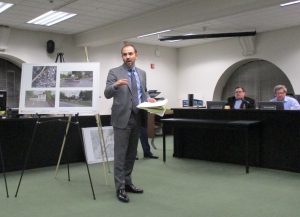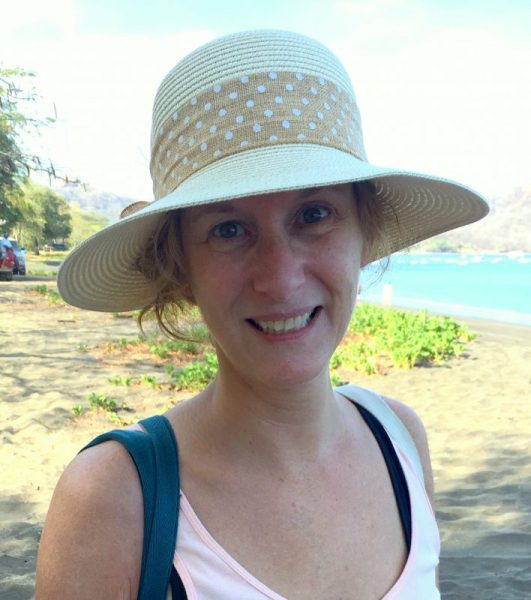P’ville’s Depew Street Project Moves Closer to Approval

Pleasantville residents raised an assortment of concerns about Lighthouse Living’s 71-unit residential project proposed for Depew Street at last Wednesday’s public hearing, as the future of the application may be determined at the next meeting.
During the three-hour hearing before the Planning Commission, speakers repeatedly expressed worries about pedestrian safety and traffic flow. The site is in close proximity to the Saw Mill Parkway-Grant Street intersection.
There were also comments questioning the project’s marketability and sustainability.
“How is traffic going to be handled on Depew and Vanderbilt (Avenue) either going out to Grant Street or to Manville (Road)?” asked village resident Bea Farley, one of about 25 residents who turned out for the hearing. “It could be a nightmare at times.”
Planning Commission Chairman Russell Klein said the applicant and the village provided two traffic analyses.
“They both generally concurred and both reports indicated there would not be a significant impact,” Klein said.
Traffic engineer Brian Dempsey, who produced the traffic study for Lighthouse, said he used higher volumes during morning and evening peak hours from surveys taken over the last three years. During the morning peak hour – 7:30 to 8:30 a.m. – the study projects that 27 cars would leave the site and eight cars would be entering, he said.
During the evening peak of 5 to 6 p.m., 28 cars would arrive at the site and 17 cars would exit.
Dempsey said the study was reviewed by the state Department of Transportation (DOT), which was satisfied that there would be no significant traffic impact.
Klein said the board had also discussed changing Depew Street to a one-way street to help the situation, but the suggestion hasn’t been fully evaluated.
Helen Meurer, chair of the village’s Conservation Advisory Council, said she was troubled that the proposed building wouldn’t be built more sustainably, noting in particular, the lack of solar panels.
“Solar is the worst technology and if it weren’t for government subsidies no one in the building industry would use them,” responded David Mann of Lighthouse Living.
He said the building’s design wouldn’t be able to evenly distribute energy generated by solar panels. The plan is to exclusively use electricity for the building.
“There’s no reason you can’t go above and beyond producing energy or having a green roof,” Meurer said. “People can do more. We should all do more.”
The key sticking point throughout the project’s review has been the building’s encroachment on the wetlands buffer. Village wetlands regulations stipulate that a structure must be at least 50 feet from the buffer. Mann asked the commission to allow some encroachment in view of “extraordinary financial hardship” so he can clean up the site’s petroleum-contaminated soil from the former LaDuca auto shop and for downsizing the building from the original plan. Mann will spend about $1.5 million under the Brownfield Cleanup Program before getting reimbursed two years later.
The Planning Commission had asked Mann for financial information proving “extraordinary hardship” to justify issuing a permit to allow Lighthouse to build in the buffer. Pleasantville Building Inspector Robert Hughes said that in lieu of providing financial information, Mann recently agreed to downsize the building and pull it further away from the buffer. The current design uses 31 square feet of buffer.
Originally, the structure used 1,752 square feet of buffer while a subsequent design reduced the incursion to 955 square feet. The latest design was accepted by the board before last week’s hearing.
The building will contain 10 studio apartments, 51 one-bedroom units and 10 two-bedroom units. Mann said he anticipated the project would attract millennials and empty-nesters.
“None of this is senior citizen friendly or family friendly,” said village resident Geraldine Stapleton, who said she wasn’t against the project but was concerned about who would live in the building. “It seems you are looking for a single- or double-income couple who are in stable jobs and can pay $2,000 or $3,000 a month and don’t want a mortgage. We are pricing ourselves out of the market in a tax sense in developing these properties. That’s all we are building in this town, a straightforward apartment with a window.”
The property currently generates $64,000 a year in taxes. Mann estimated the completed project will generate taxes of about $280,000 a year.
Others said they weren’t happy because similar to other projects in the village it was changing Pleasantville’s character.
Speakers also questioned the attractiveness of living in a building that was sandwiched between the Saw Mill Parkway and the Metro-North tracks and what would happen if the building has vacancies.
“The market shows that this is a good site,” said the applicant’s attorney David Cooper. “The village is vibrant and is attractive to millennials and down-sizers. The apartments are close to the downtown and people can walk to restaurants and stores. This type of community character and growth is what we are seeing throughout the Hudson Valley. Lighthouse wouldn’t spend the time, money and effort to remediate the brownfield contamination if the market wasn’t indicating this would be fully occupied for a long time.”
Nick Clark was one of the residents in favor of the project.
“They are going to clean it up and put it on back on the tax roll,” Clark said. “I grew up here and I am a millennial and we do walk, especially to the farmers market. I think it’s very good.”
A draft resolution to approve the Depew Street project is expected to be presented at the commission’s next meeting.

Abby is a local journalist who has reported on breaking news for more than 20 years. She currently covers community issues in The Examiner as a full-time reporter and has written for the paper since its inception in 2007. Read more from Abby’s editor-author bio here. Read Abbys’s archived work here: https://www.theexaminernews.com/author/ab-lub2019/
